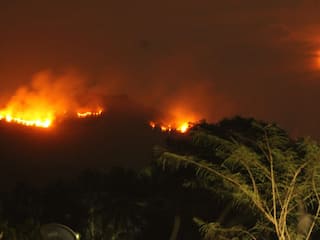Explorer
Explained: Why Cyclonic Storms Like Nisarga Rarely Hit Mumbai?
Unlike the Bay of Bengal the Arabian lesser cyclonic activities. This makes severe cyclones such as Nisarga rare. But climate change can cause such storms to become frequent.

General view of Mumbai on June 3, 2020 as cyclone Nisarga barrels towards India's western coast. - Mumbai authorities shut offices, banned small gatherings and told people to stay home on June 3 as the Indian megacity's first cyclone in more than 70 years approached. Cyclone Nisarga was expected to make landfall near the coastal town of Alibag, around 100 kilometres (60 miles) south of Mumbai, on June 3 afternoon, forecasters said. (Photo by Punit PARANJPE / AFP)
New Delhi: Cyclone Nisarga has made landfall in Alibaug, Maharashtra this afternoon. The cyclone is expected to affect Gujarat and Maharashtra. The severe cyclonic storm is causing heavy rains and winds up to 120km (75 miles) per hour on Wednesday afternoon as Cyclone Nisarga which has been termed as category 4 hit the coastal city of Alibaugh, about 98km (60 miles) south of Mumbai, according to the Indian Meteorological Department. The Arabian is sea usually sees lower cyclonic activities, according to a study published in a journal by the American Meteorological Society the Arabian Sea has only a couple of cyclonic storms and occasionally a very powerful cyclone makes landfall. The strongest storm was Gonu from 2007n which made landfall in both Oman and Iran. It also said ‘most storms (70%), and nearly all (90%) of the very severe and super cyclonic storms, form during the months of May, June, and November.’ But researchers and scientists agree, that one of the reasons for such strong cyclones is due to climate change. The Intergovernmental Panel on Climate Change (IPCC) last year came out with a special report, Ocean and Cryosphere in a Changing Climate, the report said, “There is emerging evidence for an increase in the annual global proportion of category 4 or 5 tropical cyclones in recent decades.” The temperature of the sea surface is rising due to climate change, this is fueling the cyclones as warmer seas mean the wind is moving upwards from the sea surface and causing wind speeds to be higher and higher wind speed turns to stronger storms. These storms are much likely to increase as global warming is continually rising and climate change is a dark reality. In a report, however, a researcher said that warmer oceans should not be the only parameter to look at, relative humidity in the middle troposphere, and instability in the atmosphere allowing moist air to form aiding cloud formation through the help of convection are also parameters to look at. However, the Arabian see is known to seeing an increase in cyclonic activities in the last decade. In 2019, several cyclones formed in the Arabian sea starting with cyclone Vayu which caused moderate damage in India. It was followed by Hikka, Kyarr, Maha, and Pawan. Watch how Nisarga turned into a severe cyclonic storm in a day:
Follow Breaking News on ABP Live for more latest stories and trending topics. Watch breaking news and top headlines online on ABP News LIVE TV
Read more






































